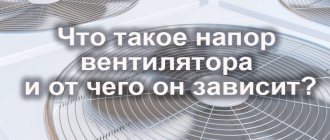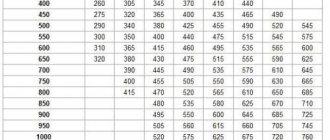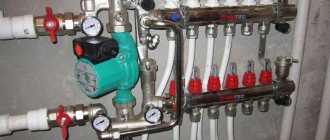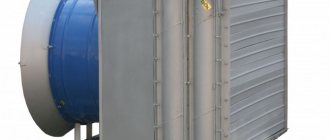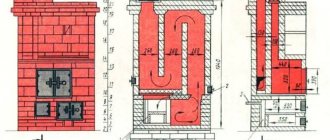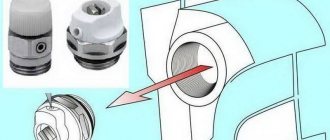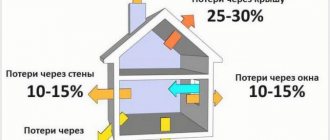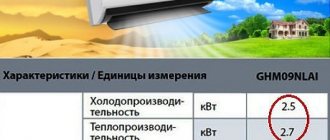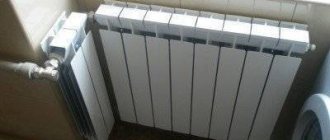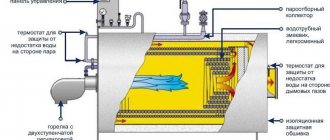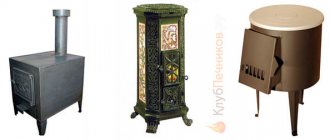- Dimensions
Performance
Scope of application of air curtains
- Thermal curtains
are used to protect domestic, public, administrative, industrial and other premises from direct contact with street air through open openings (doors, gates, windows) during the cold season. - Air curtains without a heat source
protect the openings of refrigeration and freezer chambers and rooms from contact with warm outside air or divide the space into temperature zones in warehouses and industrial premises. - In addition, the curtains cut off the flow of warm air into the air-conditioned room and prevent the penetration of unpleasant odors, gases, dust, allergens and flying insects.
- For rooms with high humidity (car washes, service stations, etc.) air curtains in a moisture-proof design (IP54)
.
Types of curtains
All existing air curtains can be classified according to the type of installation and type of coolant.
By installation type
highlight:
- Horizontal curtains
. Installed above door and window openings. - Vertical
. The assembly is installed from the protected opening if installation from above is impossible or inconvenient. For retail, office and other commercial facilities, there are designer models in the form of a column. - Embedded
. The device body is completely hidden behind the suspended ceiling.
Based on the type of coolant,
all thermal curtains are divided into 3 groups:
- Electric models
. are very popular on the market and can be used in almost any environment: from small windows for dispensing goods, vestibules and doors to large industrial gates. The advantages are the availability of coolant, simple installation and convenient control, but the disadvantage is the cost of electricity consumed during operation. - Water curtains
are chosen if there is access to a heating or hot water system. They have high thermal power, significantly save energy, but are difficult to install. Professional selection of equipment is required, taking into account all the features of the system. Maintenance required. - Gas curtains
. require a gas supply and are used in large production facilities. They have high efficiency (almost 100% efficiency), high equipment cost and low ongoing operating costs compared to electric analogues.
Electricity or hot water as heat source
Basically, electricity acts as a heat source, but there are models where hot water plays this role, it is supplied from the heating system.
Such systems are more difficult to install, but this is compensated by low costs with high equipment power. Typically, such models are used in industrial buildings where there are large open doorways.
The best posts
- Interesting ideas for a balcony: do it yourself (+40 photos)
- How can you replace tiles in the bathroom - an alternative to tiles
- Learning to knit on a knitting machine
- Crochet booties for beginners - knitting patterns and description
- Kitchen interior in red: all the pros and cons
- Wallpaper for the bedroom: photos for the walls of a small room, beautiful decoration, how to decorate, 3d, ideas, collections, gluing options, marburg, video
- Aquarium and Wine Cellar: Kevin Costner's Mansion [interior | exterior]
- What color of curtains will harmonize with blue wallpaper: expert advice
Criteria for choosing thermal curtains
To correctly choose the optimal curtain model, you need to take into account many parameters.
Dimensions
One of the main aspects when choosing a thermal curtain is the dimensions of the model. The length of the device must completely cover the door or window opening - equal to or slightly greater than the width of the opening (for horizontal installation) or its height (for vertical installation). There are models on the market with sizes ranging from 600 to 2000 mm.
You need to take into account the width of the air outlet nozzle
, and not the width of the model body. In many models, the nozzle occupies about 80% of the body length.
To cover large openings, you need to use several devices installed as close to each other as possible.
Performance
Thermal curtains are characterized by different performance, i.e., the flow rate of heated air. The larger the opening size and the higher the installation height, the greater the productivity should be.
To reliably isolate the internal space from external air masses, the minimum required air flow rate should be:
- at the exit from the nozzle: 8-9 m/s;
- at the bottom point of the window/door opening: 2.5-3 m/s.
The estimated optimal productivity value for a standard doorway with a width of 80 - 100 cm and a height of 2 - 2.2 m is from 800 to 1000 m3/h (on average 900 cubic meters / hour).
Industrial premises with high ceilings require powerful models with increased performance.
| Type | Performance (air flow) | Installation height | Scope of use |
| Mini curtains | 300 – 900 m3/h | up to 1.5 m | windows of kiosks, cash registers, windows for processing documents and issuing goods, etc. |
| Middle curtains | 1000 – 2900 m3/h | up to 3.5 m | doorways of standard sizes |
| Powerful curtains | 3000 – 8000 m3/h | up to 7 m | doors, entrances and gates of commercial and industrial buildings |
| Heavy duty industrial curtains | over 8000 m3/h | up to 20 m | large retail and industrial facilities, workshops, logistics complexes, hangars, etc. |
Power
The power is selected taking into account the temperature difference between the incoming and exhaust air, the volume of the room and the size of the opening, the passage through the opening, and the presence of a vestibule.
The greater the temperature difference between the external and internal air in the room, the more often the doors/gates are opened, the more powerful the heat curtain is required.
The required thermal power is calculated using the formula:
V*T*K
where V
– is the volume of the room in cubic meters;
T
– the difference between the outdoor temperature and the required indoor temperature (for example, if it is -5 outside and + 20 indoors, then the temperature difference will be 25 degrees);
TO
– air dispersion coefficient; depends on the degree of thermal insulation of the room. Possible values: 3.0-4.0; 2.0-2.9; 1.0-1.9; 0.6-0.9. The higher this indicator, the better the insulation. For example, a well-insulated room will have a coefficient K = 4.
The calculated value in kcal/h must be divided by 860 to obtain the calculated power in kW (1 kW = kcal/h).
With increased cross-country ability
through the opening, higher power models are required. For example, for a small cafe with a vestibule, a 3-kilowatt model will be sufficient, but for a store with a lot of door openings, up to 9 kW will be required.
In a draft
or if there are other unprotected openings, the curtain must be selected with a power reserve.
If the curtain will be installed inside the vestibule
, then you can choose a model with a power up to 30-50% lower than the calculated one.
The selected power determines the power supply and connection requirements of the device.
Household models are designed for connection to a 220 V electrical network and have a power of up to 6 kW. Commercial and industrial electric curtains of higher power require power from a 380 V network.
Low-power models up to 3 kW are connected to an electrical outlet, more powerful devices are connected through a separate cable and power terminal blocks to the electrical panel or to the control module.
Type of heating elements
Electric heat curtains use several types of heating elements:
- Spiral elements
made of nichrome, kanthal, fechral or stainless steel have a low cost, but they get very hot and burn oxygen, are characterized by high energy consumption and a relatively short service life. - Heating
elements are more expensive, but have many advantages: safe operation, long service life and lower heating temperature, due to which they do not burn oxygen. Can be used in moisture-proof curtains. - STICCH
– needle or tape heating elements located directly in front of the air outlet nozzle. The advantages of STITCH curtains include almost instantaneous heating and cooling, a relatively low price and reduced noise of the device. The disadvantages are limited power up to 9 kW, small heat exchange area, and are not suitable for wet rooms. Installation only horizontally.
Installation method
Depending on the size of the room and the design of a particular model, the curtain can be installed horizontally or vertically.
Installation horizontally
above the door is simpler in terms of installation and subsequent operation.
But it happens that horizontal installation is impossible due to the characteristics of the room or opening, then choose models for vertical
installation on the side of the opening (if the opening is wide, on both sides of the opening).
Attention!
If the air curtain is intended for horizontal installation only, it must never be installed vertically. This is fraught with equipment failure.
Some are universal
Models can be installed both horizontally and vertically.
Built-in
curtains are a good choice for rooms with a suspended ceiling or with a niche inside which it is possible to install equipment.
Attention!
Do not install the device close to the ceiling or wall: for normal operation, free space is required above or to the side of the air intake opening. The minimum distance from the device to the ceiling/wall is indicated in the technical documentation.
Range (effective jet length)
The market offers a choice of models with a range from 1.5 to 20 meters (according to the height of the air stream). This parameter is calculated for a minimum temperature difference and in the absence of drafts, so it is recommended to add a margin of up to 30%.
A correctly selected curtain should create a dense air flow over the entire area of the opening.
Door opening frequency
The more often doors/gates are opened, the more power the equipment must have. For an accurate calculation, it is advisable to seek advice from specialists.
Noise level
The noise level in dB is indicated in the technical documentation for the equipment.
For residential premises, the recommended noise level during the day is max. 40 dB.
For office, retail, etc. premises, the recommended maximum noise value is 55 dB.
Silent curtains have a noise level of up to 50-55 dB.
Control and automation
According to the control method, the curtains are divided into:
- with mechanical control
. The simplest devices are equipped with mechanical buttons for on/off, fan start and heating element activation. - with electronic control
. More complex models are equipped with an electronic control system, which provides ample opportunities for adjusting the heating temperature, adjusting power and productivity, changing the angle of the air flow, adjusting the operating time of the device and controlling the built-in thermostat. - with remote control
for remote control.
To save energy, it is possible to operate thermal curtains using a limit switch (i.e., turning the device on and off along with opening/closing the gate).
Depending on the purpose and type of curtains, it is possible to connect additional automation and control elements: external control panels, external thermostats, thermal control units, frost protection thermostats, fire alarm devices, etc.
Additional functions
Different curtain models have various additional functions.
- The built-in thermostat makes it possible to maintain the set temperature in the room and save energy.
- Shutting down when overheating protects equipment from premature failure.
- Automatic delay in turning off the fans after turning off the heating elements (to purge them).
- Operating mode without heating. Used in the warm season to prevent the penetration of hot air into the room, fire, gases, odors, and insects.
Design requirements
For rooms with increased requirements for appearance, interior models with interesting designs are being developed, or hidden installation of fully built-in heat curtains behind suspended ceilings and niches is possible.
Let's summarize the main recommendations for choosing
- Depending on the available heat sources, the desired type of curtain is selected - electric, water or gas.
- The first most important selection criterion is dimensions. The length of the curtain must completely cover the width/height of the opening. In the case of a wide/high opening, you need to select several devices to completely cover the entire size of the opening with air flow.
- Performance. To provide the required effective barrier to outside air, the model must pump a sufficient volume of air per unit time.
- The power is selected according to a formula and adjusted depending on the frequency of opening the doors/gates.
- The installation method is selected depending on the configuration of the room.
- Design, equipment and control method - individually depending on your wishes.
Curtain Control
You can control the heat curtain using a remote control, which can be remote or built-in.
The specified equipment must have at least two switches that allow you to turn on the heater and fan. More expensive models have the ability to stepwise regulate the heater power and fan speed.
This equipment can be controlled using a remote or built-in control panel. Usually small curtains have built-in control panels, while industrial curtains are controlled remotely, since it will be difficult to reach their buttons.
Some models are additionally equipped with a thermostat, which allows you to turn off the heating elements or the entire equipment when the set temperature in the room is reached.
Industrial models often use limit switches, which allows thermal protection to be turned on only when the door is opened. This saves energy. For ordinary doors, this method of saving is not used, since it takes 5-10 seconds to reach operating parameters, and during this time the doors will already close.
To protect against overheating, almost all models have several degrees of protection: without turning on the fan, the heating element is not connected; when the temperature of the heating element reaches 80-110°C, the power is turned off.
Related article: Attic bedroom: features, design recommendations, photos
Vertical protection, unlike horizontal protection, is installed on the side of the doorway. It is no different from horizontal, and its height should be at least 3/4 of the height of the opening.
